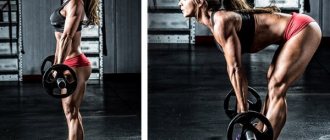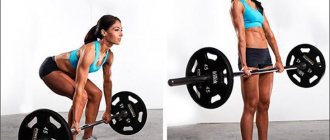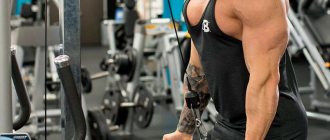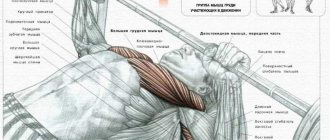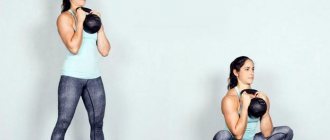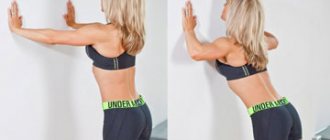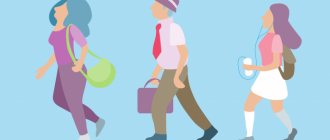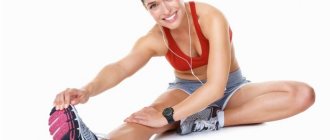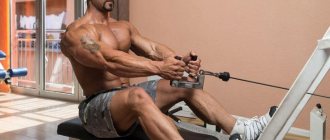The chest pull-down is an exercise for developing the latissimus dorsi muscles. It allows you to build a beautiful V-shaped figure, eliminates postural disorders, and serves as a prevention of scoliosis. The movement helps correct "forward rolled" shoulders and is not only an exercise for bodybuilders, but also a good assistance movement for the bench press and holding the barbell on your back during the squat. Variations in the movement depending on the width of the grip and the direction of the palms allow you to involve or exclude the biceps from the movement. The exercise serves as an accessible alternative to pull-ups, which some cannot do due to the anatomical position of the shoulders, excess weight, muscle weakness and injuries. The lat pulldown allows you to use one of the largest muscle groups, speed up your metabolism and burn fat if necessary. It is also included in mass-building programs as a good multi-joint exercise that builds strength and mass. The result of a workout depends not only on technique and style, but also on the entire program and the athlete’s nutrition. The movement is suitable for both men and women, and can be used in the general physical training of adolescents and children.
What muscles work
Main movers:
- Both are wide;
- Rhomboid muscles;
- Biceps
Movement aids and stabilizers:
- Large pectorals;
- Press;
- Trapezoidal;
- Muscles of the palm and forearm;
- Longus dorsi muscle
During the exercise, static tension in the muscles of the thighs and buttocks is possible if the athlete is accustomed to resting his feet on the floor in order to help himself well during the training process. But this should not be considered as a training activity. Trapezius work (shoulder lifts) is also discouraged and is only done if the lifter is advanced enough to perform the movement with a slight cheat.
The technique is performed only in the gym on a special simulator
The overhead pull-down is suitable for expanding the size of the torso due to the growth (hypertrophy) of the latissimus muscles. Simulates standard pull-ups, as it works a large number of muscles. However, it has its advantages compared to pull-ups.
On the simulator, you can adjust the weight and exercise in a descending pattern, even for beginners, that is, gradually increase the load. This allows you to make a larger range of motion and, accordingly, better work out the torso.
Advantages:
- Increasing the width of the back.
- V-shaped torso and thin waist.
- Smooth posture.
- Muscular and sculpted torso.
- Availability and ease of implementation.
- Suitable for those who cannot do pull-ups.
- Suitable for beginners.
- Suitable for men and women.
Unlike the front row, which targets the rhomboids and increases their thickness, the overhead row increases the width of the muscles.
Wide grip lat row
The lat pulldown with a wide straight grip (on the chest) is the most common option in fitness. The movement is suitable for those who cannot pull their heads, pull themselves up, or perform other movements. This exercise allows you to pump up the latissimus muscles, even if people have problems with strength and shoulder flexibility.
By training in a simulator, you can build up the “width of your back,” as athletes say. This movement allows you to press your shoulder blades towards your back and correct your posture. The exercise will help prepare the body for strength work - deadlifts and pull-ups.
Correct technique
- You need to choose the width of your grip so that your hands are slightly wider than your shoulders, but your shoulders can drop down and your shoulder blades can “pull” towards your spine;
- The grip is performed closed, standing facing the machine;
- Then the upper back bends slightly, the shoulders are removed from the ears, the shoulder blades are pulled towards the spine;
- The athlete sits on the machine bench, the body leans back a little, the chest rises up;
- The shoulders need to be turned back a little;
- The shoulder blades are pulled towards the spine;
- The lats gather, tighten towards the spine;
- Then the handle of the simulator is brought to the top of the chest;
- Peak muscle contraction is performed;
- The reverse movement consists of lowering the handle back
The movement is performed smoothly, without any pushing or jerking. It is important not to pull your biceps, not to throw your shoulders towards your ears, and not to yank the handle too hard. It is important to move the handle smoothly and not make the extension of your arms too large. Athletes think that the wider the grip, the better the back work, but this is not true. The grip should be chosen to be comfortable, so that it does not interfere with the work of the muscles.
Back workout. Upper block pull.
Common mistakes
- The most common mistake is the biceps pull. The first thing a person does is bend his elbows, and by contracting his biceps, he pulls the handle toward his chest. This is not correct, and takes the strain off the back;
- You should not pull due to inertia, tilting the body back, and pulling the handle to the top of the back with a jerk;
- Pull to the middle of the abdomen without arching the back or tilting the body. This only allows you to pump up your biceps and “hammer” your trapezius, so you shouldn’t do that;
- It is better to avoid the option when the weight is too heavy and the person is literally “thrown” up;
- Throwing your elbows back allows you to develop exclusively the posterior deltoid muscle, but not the latissimus or rhomboid muscles;
- “Humping”, that is, rounding the back in the thoracic region, can lead to injury in the shoulder joint and remove the load from the target muscles
It is important to understand that this version of the exercise is for the upper bundles of the latissimus muscles. If the lower ones are not loaded, nothing bad happens. Is it possible to pull the block by the head? Modern fitness trainers rarely give their clients this exercise. Meanwhile, in bodybuilding and powerlifting it is used quite often. A condition for using this movement safely is good mobility of the shoulder joint. Pulls for the head are performed with significantly less weight than for the chest. It more specifically works the rhomboid muscles and helps retract the shoulder blades and stabilize the back in all strength exercises.
It's a lat pulldown, baby!
Contraindications
This exercise has virtually no contraindications. These include only injuries to the shoulder girdle, hands or elbows. In addition, you must carefully perform this exercise if you have a hernia in the thoracic spine. In general, if you have any pathologies, you must first consult a doctor and, if necessary, conduct training focused on your problems. It is worth noting that rowing on a simulator is also used in rehabilitation centers, but it must be performed under supervision.
Another important detail is that vertical rows with a wide grip behind the head are suitable only for those who have a mobile shoulder girdle and allow them to perform a similar range of movements. If you feel that you cannot fully perform the exercise without compromising technique, then limit it to a regular or narrow grip and pull to the chest.
Pulldowns with a medium reverse grip
This version of the exercise works the lower bundle of the latissimus muscles, it does not allow you to emphasize the load on the top, this is not necessary. Many athletes choose heavier weights for reverse grip deadlifts, but this is wrong. It turns out that the load goes to the biceps. It is better to take medium resistance or weight and pull the block, as if meeting the handle of the machine with your chest.
Correct technique
- The grip is shoulder-width apart, not narrower; a narrower hand position requires a special handle with double symmetrical handles to maintain healthy shoulders;
- On a regular handle, grab the notch in the middle, or, if there is none, the handle with gloved hands;
- The palms should be directed towards the athlete's face;
- They sit on the machine bench when the grip is already set and the fingers tightly clasp the handle;
- Then the arms seem to stretch upward, the shoulder blades are assembled towards the spine, the body is tilted back;
- By contracting the latissimus dorsi muscles, the athlete brings the handle of the exercise machine to the top of the chest;
- In this case, the forearms move along the body, the elbows move towards the floor;
- You should not put your elbows behind your back, as well as excessively contract your biceps;
- The reverse movement consists of gradually relaxing the back and moving the handle back;
- The arms are fully extended at the top point of the exercise.
Reverse grip lat pulldown: execution technique
Technical errors
- A grip error is holding the handle on your fingertips. This leads to overload of the forearms and a shift in emphasis to them. The forearms become clogged and the athlete cannot complete the required number of approaches and repetitions;
- It is technically incorrect to pull exclusively with the biceps, as if taking the back out of the range of work. From the outside it looks as if the athlete is pulling the handle with his hands and bringing it to his shoulders by bending his arms at the elbow joint;
- You can’t turn on the press too much; this usually happens due to the incorrectly chosen weight of the burden, and the tendency to twist forward, as it were, and pull the lower ribs towards the pelvic bones. This movement helps unload the back muscles, so it is unacceptable
Possible mistakes
To minimize the risk of injury while performing vertical rows in a machine, it is recommended that the athlete avoid the most common mistakes.
| Possible error | Consequences of its implementation |
| Excessive body movement forward or backward. |
|
| Excessively large distance between hands with a wide grip. |
|
| Insufficient retraction of the shoulder blades when the hands are at the lowest point. |
|
| Insufficient fixation of the legs with soft rollers |
|
| Ignoring the “bear grip” (thumb on the bottom of the bar, the other 4 fingers on top). | Shifting the load on the wrist muscles. |
Parallel grip lat pulldown to chest
This exercise serves to build perfect symmetry. It gives the latissimus dorsi muscle ideal contours and helps correct muscle imbalances. Due to its biomechanical nature, the movement puts more stress on the back and less on the biceps; even a beginner can isolate his back enough to make his workout more effective.
To perform the movement, you will need a special handle for a parallel grip; this is a handle with two handles shoulder-width apart. The problem may be that the handle does not fit the person in length, and anthropometrically does not allow the movement to be performed correctly and with full load. But for most body types, standard gym handles are a suitable option.
Correct technique
- You need to attach the handle for a parallel grip to the simulator or to the upper block of the crossover;
- Grip – parallel with palms facing each other, palm resting on the handle of the machine;
- Lowering the handle of the projectile begins with activating the lats;
- The elbows are brought to the body so as to ensure contact with the handle and the top of the chest;
- At the lowest point – peak contraction of the back muscles;
- Then – smoothly bring the handle of the simulator upward.
Parallel grip lat pulldown: technique and nuances
Tips and implementation features
In order to properly organize the training process, the athlete should study in advance the features of performing vertical deadlifts:
- during the exercise, the spine should remain straight (if at the moment it is not physically possible to accept such a position of the body, then the load in the block simulator should be postponed. You should start doing it again only if you have acquired sufficient flexibility and mobility of the joints);
- to get rid of additional “harmful” load on the hands and forearms, it is permissible to use special straps when performing lat pull-downs (you can purchase them at a store specializing in the sale of sports equipment);
- when working in the simulator, it is recommended to sit on the support bench strictly under the moving cable (this body position will ensure correct distribution of the load while pulling the bar towards you);
- so that deadlifts can be performed smoothly, following the trainer’s recommendations and generally accepted technique (avoid jerking), the girl should select the working weight gradually, starting from 3-5 kg.
Basic rules for completing a workout
To prevent soreness caused by the accumulation of lactic acid in the muscles after exercise, you must adhere to the following recommendations:
- Every time before training, do a warm-up, and then stretch: standing straight, bend your chest forward, move your pelvis back. Bend your back at the thoracic region, then bend it back as far as possible. Bring your shoulders forward, stretch your arms forward and down. Move your chin following your hands. Stretch your arms as far as possible and return to the starting position. The tension should be felt in the area of the shoulder blades.
- End each workout with aerobic exercise (10 minutes on an exercise bike or treadmill).
- After each approach, take a break for 30 seconds.
Comprehensive muscle strengthening program
To effectively and efficiently work out all three groups of spinal muscles, overhead pull-downs are combined with other basic strength exercises:
- longitudinal press;
- bent over T-bar pull;
- lifting weights in a bent position with pauses;
- pulling dumbbells to the belt;
- pullovers;
- vertical lifting of weights with one hand;
- Pull-ups on the bar.
It is not necessary to do all the exercises at once; it is enough to alternate several of them 2-3 times a week.
Female representatives, depending on their goals, can work both on strength indicators for the relief of the body, and on “drying” the upper back and shoulder girdle. Since girls find it difficult to do classic pull-ups on a bar, this exercise will help achieve a beautiful back shape.
